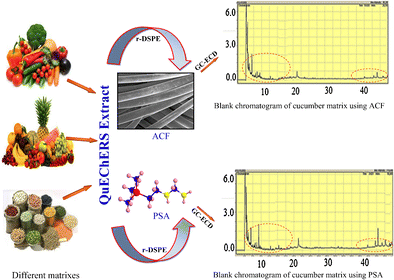Analytical and Bioanalytical Chemistry ( IF 4.3 ) Pub Date : 2018-02-12 , DOI: 10.1007/s00216-018-0894-0 Shiv Singh , Anshuman Srivastava , Sheelendra Pratap Singh
Phenolic resin based activated carbon fibers (ACFs) were applied for the first time as a reversed-dispersive solid-phase extraction (r-DSPE) sorbent. A modified quick, easy, cheap, effective, rugged, and safe (QuEChERS) method was applied to determine 26 pesticides (organophosphates, organochlorines, synthetic pyrethroids, and herbicides) in different complex matrices, including cauliflower, cucumber, banana, apple, wheat, and black gram. Different physicochemical characterization techniques were used to investigate the engineering and structural properties of the r-DSPE sorbent. All the chromatographic analyses were performed with a gas chromatograph equipped with an electron capture detector. The recoveries of all 26 pesticides were acceptable (70–120%), with relative standard deviations of less than 15%. The limit of detection and the limit of quantification were 1.13–5.48 ng/g and 3.42–16.60 ng/g, respectively. In the original QuEChERS method, primary secondary amine is extensively used as the r-DSPE sorbent in the cleanup process, but it is eightfold more expensive than the ACFs used in this study. Therefore, the modified QuEChERS method using ACFs during the cleanup process is more efficient, cheaper, and more robust to determine pesticides from different types of matrices, including vegetables, grains, and fruits, and ACFs could be used as a cost-effective alternative to primary secondary amine.

Sample clean-up using PSA and ACF as r-DSPE sorbent in QuEChERS method
中文翻译:

廉价,有效的新型活性炭纤维用于样品净化:使用QuEChERS方法在食品中的多种农药残留分析中的应用
首次使用酚醛树脂基活性炭纤维(ACF)作为反向分散固相萃取(r-DSPE)吸附剂。采用改良的快速,简便,廉价,有效,坚固耐用且安全的(QuEChERS)方法来测定不同复杂基质中的26种农药(有机磷酸盐,有机氯,合成拟除虫菊酯和除草剂),包括花椰菜,黄瓜,香蕉,苹果,小麦和黑克。使用了不同的物理化学表征技术来研究r-DSPE吸附剂的工程和结构特性。所有的色谱分析均使用配有电子捕获检测器的气相色谱仪进行。所有26种农药的回收率均可接受(70–120%),相对标准偏差小于15%。检测限和定量限分别为1.13–5.48 ng / g和3.42–16.60 ng / g。在最初的QuEChERS方法中,伯仲胺被广泛用作净化过程中的r-DSPE吸附剂,但它比本研究中使用的ACF贵八倍。因此,在净化过程中使用ACF的改良QuEChERS方法能够更有效,更便宜且更可靠地从不同类型的基质(包括蔬菜,谷物和水果)中测定农药,而ACF可以用作替代成本效益的替代方法。伯仲胺。但是它比本研究中使用的ACF贵八倍。因此,在净化过程中使用ACF的改良QuEChERS方法能够更有效,更便宜且更可靠地从不同类型的基质(包括蔬菜,谷物和水果)中测定农药,而ACF可以用作替代成本效益的替代方法。伯仲胺。但是它比本研究中使用的ACF贵八倍。因此,在净化过程中使用ACF的改良QuEChERS方法能够更有效,更便宜且更可靠地从不同类型的基质(包括蔬菜,谷物和水果)中测定农药,而ACF可以用作替代成本效益的替代方法。伯仲胺。

在QuEChERS方法中使用PSA和ACF作为r-DSPE吸附剂进行样品净化



























 京公网安备 11010802027423号
京公网安备 11010802027423号